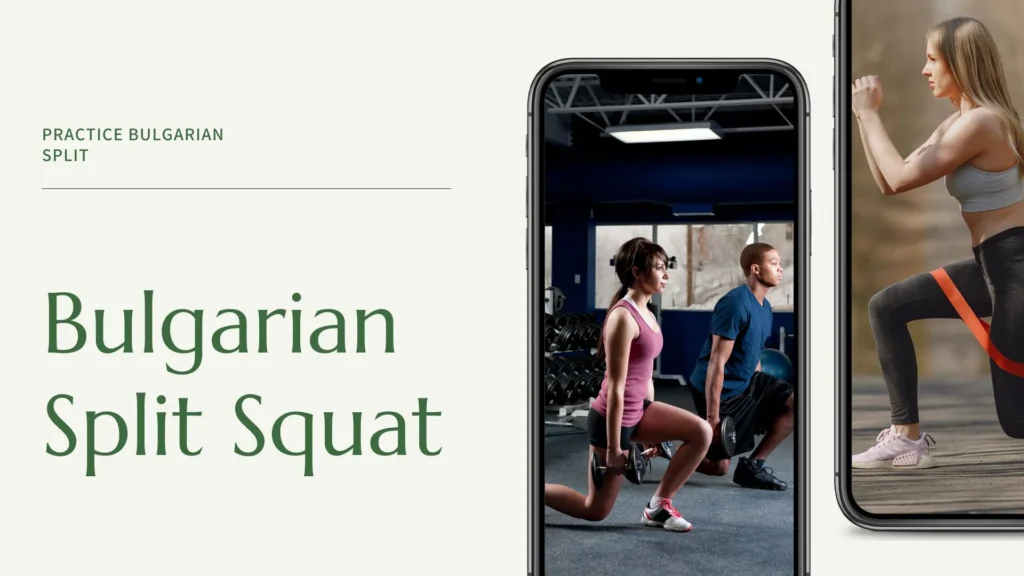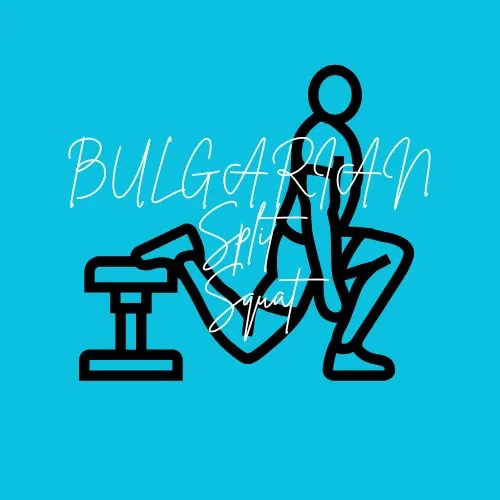One of the most effective exercises for strength training is the Bulgarian split Squat, especially for leg day. This exercise builds your metabolism and builds a leaner body. It focuses on your quads, hamstrings, core, and glutes. It also challenges your balance and flexibility.
Including this in your workout routine can make you gain strength, improve athletic performance, and tone your body. This workout routine will be covered in detail, from the setup to the common mistakes trainers face. Different variations of it will also be included for better understanding
What is Bulgarian Squat?
Bulgarian Squat is known to be a lunge variation. In the typical lunge, both feet are on the ground, but in this case, one foot is elevated on a bench or a step behind you. This makes the exercise more effective because the focus is on the targeted muscle. The main muscles targeted is the hamstrings, quads, glutes, and calves. The engagement in the core also provides stability and balance.
Bulgarian Split Squats can have anywhere from 70-85% of total force coming through the front leg, depending on how high your rear-foot platform is and how heavy you go. In the opinion of different trainers, the quadriceps and glutes do too much work for the hamstrings to work like they would in the Romanian deadlift or the Hamstring curl.
The equipment requires performing the Bulgarian split squat.
The right equipment is needed to perform these squats before you start. The one main thing that is needed is a bench or an elevated surface, and the other is weights, which can be optional in some cases. The height of the bench should be around your knee height or a little below. The bench should be flat or maybe a sturdy chair; even a step can work in this.
The thing requires it should be stable and strong enough to hold your weight. Bulgarian split squats can be performed using just your body weight, but for it to be more effective, increasing your muscle size or increasing strength can help. Start with a manageable weight and increase the weight slowly.

Guide to perform Bulgarian Squats
Let’s walk through the basics of performing the squat. We’ll break it into six easy-to-follow steps.
1. Find a bench of your knee height or below and position yourself in front. Your back will face the bench. The important thing is to find the right distance between yourself and the bench. Make sure you’re when you lower your body; your knee doesn’t extend too far over your toes.
2. The second step is to place one of you on the bench. Once you find the right distance, place your foot on the bench. The top of your foot needs to be resting down, and your knee should be facing down. Your back leg should be completely extended, and your toes should be pointed down.
3. Now, the most crucial task is doing it the right way. To make them more effective, engage your core. It’s important to maintain balance and protect your lower back. Keep your chest lifted, your shoulders back, and your gaze forward. Keeping a proper and engaged posture will help you with balance and stability.
4. Now you start lowering your body. That’s the fun part. Slowly lower your body by bending your front knee and keeping your torso upright. A 90-degree angle should be made between the two knees, and your front knee should not go beyond your toes. If it’s traveling far, step back a little and try again. Lower yourself until your back knee is just above the ground.
5. After lowering yourself, engage your healing to push yourself back up to the starting point. Keep your movement controlled and don’t rush it. After strain, your knee doesn’t lock it; keep it a little bent. It will keep the tension on the muscle, which is crucial for building strength.
6. Perform 8-12 reps on one leg and then switch to your second leg. Maintaining good form and engaging your core is crucial. You can perform 3-4 sets on each leg, resting between.
Benefits of Bulgarian Squats
It is an essential exercise in your strength training routine that offers several benefits. Let’s discuss these benefits and why you should incorporate this into your routine.
This routine, known as Bulgarian Split Squats, targets your hamstrings, glutes, and quadriceps. Isolation of each leg leads to balanced strength between the two sides. This helps develop and improve muscle definition and tone.
Bulgarian split squats can help you improve balance and stability. Since this exercise is a unilateral exercise, it challenges your balance. Stabilize your body on one leg while lowering yourself to squat and engaging your core muscles throughout the movement. O Over time, this improves overall body control, stability, and coordination. This risk of injury can be mitigated by strengthening your core and leg muscles.
One of the major advantages of this exercise is its ability to address muscle imbalance. It’s a certain common time for one leg to be more dominant than the other, but with this expansion, the strength and balance can be improved. Eventually, the work improved overall stability and function.
It’s an exercise common among athletes who require unilateral strength. It mimics the single-leg moves you then perform in sports like running, jumping, and swimming. Its ability to train the muscles of the legs independently can enhance performance and reduce the risk of injuries from muscle imbalance or weakness.
One of the hidden benefits of Bulgarian squats is their work on the core. As you lower yourself to a squat, your core has to be engaged, which helps in an upright posture. Over time, this will help you improve your core strength, which is essential for all functional movements.

Mistakes to avoid
Every adventure comes with its own challenges, and this one is no exception. There are a few common mistakes that should be avoided while performing this exercise. Let’s start from the start.
One of the most common mistakes is letting your knee travel far beyond your toes. Due to this, unnecessary stress can be on the knee joint and lead to injury. To avoid this, make sure your knees stay aligned with your toes.
Your posture is the second most important thing. For this exercise, you need your posture to be upright. If you have a rounded back, it can lead to poor posture and injury, especially to your lower back. Keep your chest lifted and your shoulders back throughout meditation. Engage your core to maintain a neutral spine.
Another mistake is leaning too far forward during your movement; it takes focus off your legs and puts unnecessary strain on your lower back. To avoid this, keep your toe upright and avoid leaning forward. The move should come from your legs, not your back.
The most repeated mistake is not engaging your core. To stay balanced and protect your spine, always engage your core. Not doing so will eventually lead to injury.
These are the mistakes that should be avoided to always get the desired results and protection from injury.
Different valuations of Bulgarian squats
After mastering the Bulgarian squats, you can challenge yourself with different variations:
Weighted Bulgarian Split Squat
Bulgarian split squats are a type of single-leg squat exercise that involves placing one leg behind you and elevating it off the ground, commonly on a bench, bar, or other surface. To add extra resistance, hold a dumbbell or a barbell. You can hold dumbbells side by side; this will increase the intensity and help you build more strength.
Bulgarian Split Squat Jump
To have an explosive element in your routine of Bulgarian split squat, try the Bulgarian split squat jump. From the lowered position, push off explosively and jump, switching legs in midair. This variation will help build drivers and speed.
The Dynamic Barbell: The Bulgarian Split Squat
You’ll need to utilize bands and a barbell for this one. I don’t advise somebody who is just beginning split squats to try this advanced variation. This exercise aims to increase your capacity to produce power, or strength, as quickly as possible. You want to maintain proper posture while quickly rising from the bottom of the split squat to execute this exercise correctly.
This is one of those workouts that you can perform just once and see results right away. Perform 3-5 sets of 4-6 repetitions per side. You’ll gain lower-body explosiveness, run faster, and jump higher.
Split Squat Zercher Bulgarian
Seriously, Zercher exercises are the finest. You can include them in your routine in a variety of ways. Among these are farmer carries, lunges, Zercher squats, and good mornings. The advantages of this split squat variant include challenging your upper body and core while simultaneously increasing load with the barbell.
Your core is put to the test whenever you have weight in front of your body, which helps stabilize your spine. This type of front-loaded position also puts more of an emphasis on your quadriceps.
Conclusion
To improve muscle stability and build strength in the legs while also improving balance and addressing muscle imbalance, the Bulgarian squat helps in all of these. It is an incredible exercise for your lower body workout. Whether you’re looking to get stronger, prevent injury, or simply tone your lower body, this exercise is perfect for you. Try to avoid the common mistakes for improvement.
Start with proper form, and your body weight and grade increase resistance by adding additional weights as you get stronger. With consistent practice, the Bulgarian split squat will become one of your go-to exercises for a strong and toned leg.
